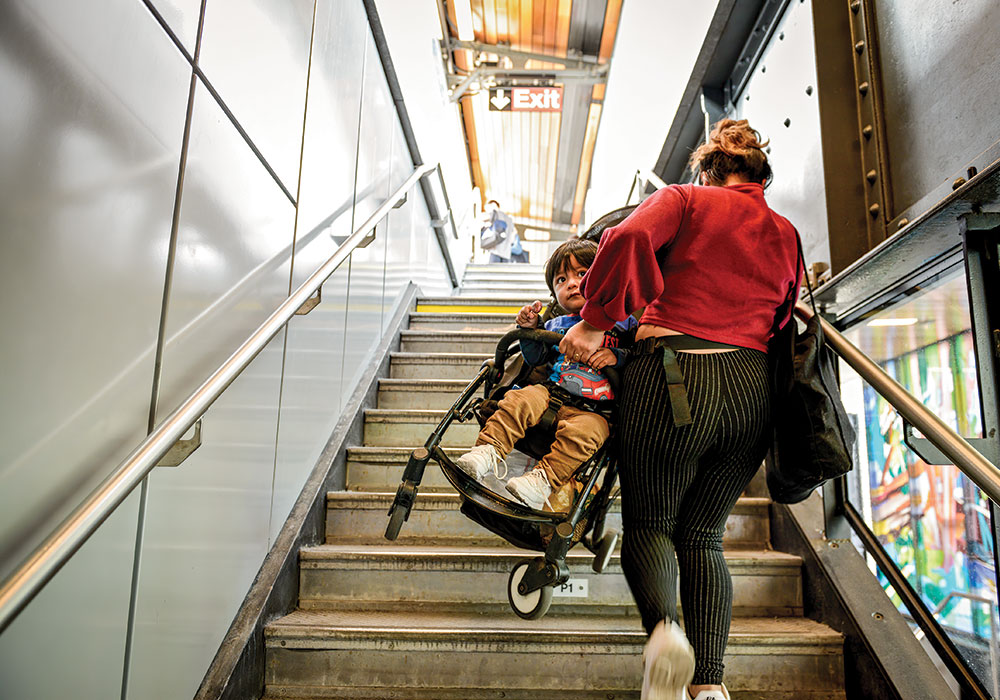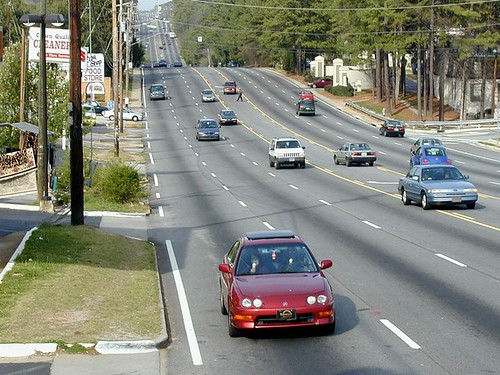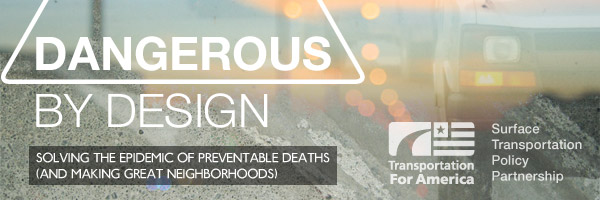
Dangerous by Design
 |
| YikesPedestrian Originally uploaded by Transportation for America |
| Look carefully in the turning lane above the center of the photograph. There’s a pedestrian trying to cross this 7-lane urban arterial road. See any crosswalks anywhere on the road? Photo courtesy of Dan Burden. |
Over the last several decades, many of our cities and communities have seen the same shift of daily business from walkable, downtown Main Streets to wide, fast-moving state highways. These “arterial” roads are the new main streets in most communities, drawing shopping centers, drive-throughs, apartment complexes and office parks. Unlike the old walkable main streets, however, the pressure to move as many cars through these areas as quickly as possible has led transportation departments to squeeze in as many lanes as they can, while disregarding sidewalks, crosswalks and crossing signals, on-street parking, and even street trees in order to remove impediments to speeding traffic.
As a result, more than half of fatal vehicle crashes occurred on these wide, high capacity and high-speed thoroughfares. Though dangerous, these arterials are all but unavoidable because they are the trunk lines carrying most local traffic and supporting nearly all the commercial activity essential to daily life.
Before the top 10 most dangerous city rankings, here are just a few facts you might like to know:
Inadequate facilities. Of the 9,168 pedestrian fatalities in 2007-08 for which the location of the collision is known, more than 40 percent were killed where no crosswalk was available.
Spending disparity. Though pedestrian fatalities make up 11.8 percent of all traffic-related fatalities, states have allocated less than 1.5 percent of total authorized transportation funds to projects aimed at improving safety for pedestrians (for funds spent under current transportation bill.) No state spends more than 5 percent of federal transportation funds on safety features or programs for pedestrians or cyclists, despite a 30 percent increase in total federal transportation dollars beginning in 2005.
Complete streets save lives. Providing sidewalks, crosswalks and designing for lower traffic speeds saves lives. Only one in 10 pedestrians deaths occurred within crosswalks, while six in 10 occurred on arterial-type roads where speeds were 40 mph or higher.
The danger is not shared equally. Older adults, disabled and low-income Americans are being killed at disproportionate rates. African-Americans, who walk for 50 percent more trips than whites, and Hispanic residents, who walk 40 percent more, are subjected to the least safe conditions and die disproportionately.
Aging in place, yet unable to leave the house on foot. An AARP poll of adults 50 years and older found that 40 percent reported inadequate sidewalks in their neighborhoods and nearly half of respondents reported that they could not safely cross the main roads close to their home.
| Rank | Metropolitan Area | 2007-08 Pedestrian
Danger Index |
|
| 1 | Orlando-Kissimmee, Fla. | 221.5 | |
| 2 | Tampa-St. Petersburg-Clearwater, Fla. | 205.5 | |
| 3 | Miami-Fort Lauderdale-Pompano Beach, Fla. | 181.2 | |
| 4 | Jacksonville, Fla. | 157.4 | |
| 5 | Memphis, Tenn.-Miss.-Ark. | 137.7 | |
| 6 | Raleigh-Cary, N.C. | 128.6 | |
| 7 | Louisville/Jefferson County, Ky.-Ind. | 114.8 | |
| 8 | Houston-Sugar Land-Baytown, Texas | 112.4 | |
| 8 | Birmingham-Hoover, Ala. | 110.0 | |
| 10 | Atlanta-Sandy Springs-Marietta, Ga. | 108.3 | |
| See the full rankings and download the report | |||




